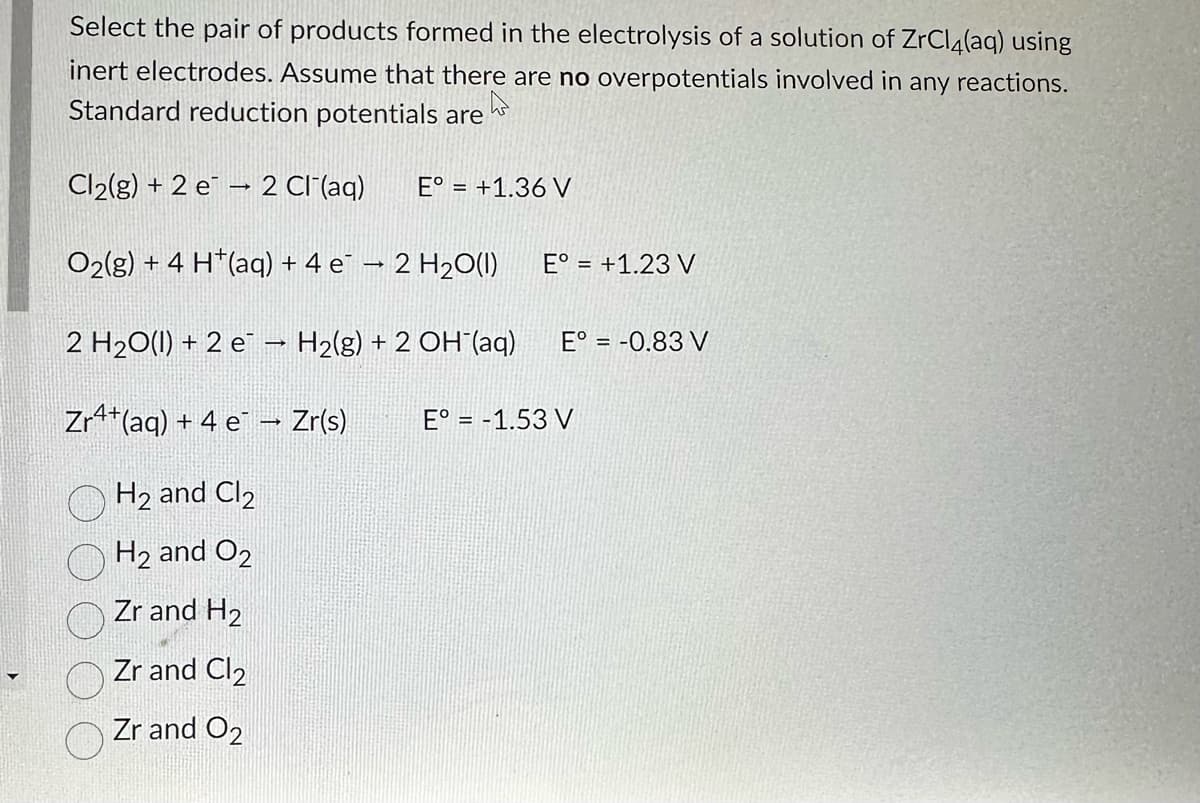Select the pair of products formed in the electrolysis of a solution of ZrCl4(aq) using inert electrodes. Assume that there are no overpotentials involved in any reactions. Standard reduction potentials are hs Cl₂(g) +2 e 2 Cl¯(aq) E° = +1.36 V O2(g) + 4 H*(aq) + 4 e → 2 H2O(I) 2 H2O(I) + 2 e → H2(g) + 2 OH (aq) E° = -0.83 V Zr4+ (aq) + 4 e H₂ and Cl₂ H₂ and O2 Zr and H₂ Zr and Cl₂ Zr and O₂ M Zr(s) E° = +1.23 V E° = -1.53 V
Select the pair of products formed in the electrolysis of a solution of ZrCl4(aq) using inert electrodes. Assume that there are no overpotentials involved in any reactions. Standard reduction potentials are hs Cl₂(g) +2 e 2 Cl¯(aq) E° = +1.36 V O2(g) + 4 H*(aq) + 4 e → 2 H2O(I) 2 H2O(I) + 2 e → H2(g) + 2 OH (aq) E° = -0.83 V Zr4+ (aq) + 4 e H₂ and Cl₂ H₂ and O2 Zr and H₂ Zr and Cl₂ Zr and O₂ M Zr(s) E° = +1.23 V E° = -1.53 V
Chemistry
10th Edition
ISBN:9781305957404
Author:Steven S. Zumdahl, Susan A. Zumdahl, Donald J. DeCoste
Publisher:Steven S. Zumdahl, Susan A. Zumdahl, Donald J. DeCoste
Chapter1: Chemical Foundations
Section: Chapter Questions
Problem 1RQ: Define and explain the differences between the following terms. a. law and theory b. theory and...
Related questions
Question

Transcribed Image Text:Faraday Constant: F = 96,485.3 C/mol
Gas Constant: R = 8.3145 J K-1 mol-1 = 0.082057 L atm K-1 mol-1
Pressure: 1 atm = 1.01325 bar = 760 Torr
Temperature: 273.15 K = 0 °C
=
RT/F = 0.025693 V at T = 298.15 K
101325 Pa

Transcribed Image Text:Select the pair of products formed in the electrolysis of a solution of ZrCl4(aq) using
inert electrodes. Assume that there are no overpotentials involved in any
reactions.
Standard reduction potentials are
Cl₂(g) + 2 e 2 Cl¯(aq) E° = +1.36 V
O2(g) + 4 H*(aq) + 4 e − 2 H2O(I)
2 H2O(l) + 2 e → H2(g) + 2 OH (aq) E° = -0.83 V
Zr4+ (aq) + 4e¯ → Zr(s)
H₂ and Cl₂
H₂ and O2
Zr and H₂
Zr and Cl₂
Zr and O2
E° = +1.23 V
E° = -1.53 V
Expert Solution
This question has been solved!
Explore an expertly crafted, step-by-step solution for a thorough understanding of key concepts.
This is a popular solution!
Trending now
This is a popular solution!
Step by step
Solved in 2 steps

Knowledge Booster
Learn more about
Need a deep-dive on the concept behind this application? Look no further. Learn more about this topic, chemistry and related others by exploring similar questions and additional content below.Recommended textbooks for you

Chemistry
Chemistry
ISBN:
9781305957404
Author:
Steven S. Zumdahl, Susan A. Zumdahl, Donald J. DeCoste
Publisher:
Cengage Learning

Chemistry
Chemistry
ISBN:
9781259911156
Author:
Raymond Chang Dr., Jason Overby Professor
Publisher:
McGraw-Hill Education

Principles of Instrumental Analysis
Chemistry
ISBN:
9781305577213
Author:
Douglas A. Skoog, F. James Holler, Stanley R. Crouch
Publisher:
Cengage Learning

Chemistry
Chemistry
ISBN:
9781305957404
Author:
Steven S. Zumdahl, Susan A. Zumdahl, Donald J. DeCoste
Publisher:
Cengage Learning

Chemistry
Chemistry
ISBN:
9781259911156
Author:
Raymond Chang Dr., Jason Overby Professor
Publisher:
McGraw-Hill Education

Principles of Instrumental Analysis
Chemistry
ISBN:
9781305577213
Author:
Douglas A. Skoog, F. James Holler, Stanley R. Crouch
Publisher:
Cengage Learning

Organic Chemistry
Chemistry
ISBN:
9780078021558
Author:
Janice Gorzynski Smith Dr.
Publisher:
McGraw-Hill Education

Chemistry: Principles and Reactions
Chemistry
ISBN:
9781305079373
Author:
William L. Masterton, Cecile N. Hurley
Publisher:
Cengage Learning

Elementary Principles of Chemical Processes, Bind…
Chemistry
ISBN:
9781118431221
Author:
Richard M. Felder, Ronald W. Rousseau, Lisa G. Bullard
Publisher:
WILEY